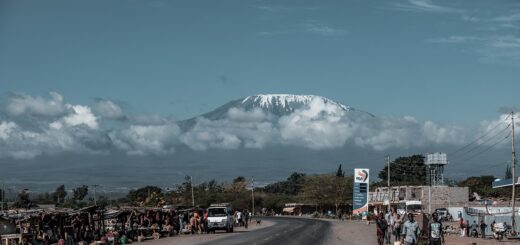When is the Wildebeest Migration- Serengeti-Mara ecosystem
The wildebeest migration is noted as a wonder of the world, it’s said to be a chance to witness nature at its best. There has not been such great movement of wild animals witnessed in the world like these. Over two million animals move from The Serengeti National Park in Tanzania to The Maasai Mara Game Reserve in Kenya in such of pasture.
Some people argue that there is no specific time when the wildebeest migration happens, as the animals are known to migrate clockwise along with the Serengeti-Mara ecosystem. Over a million wildebeest are joined by Thomson gazelles, grant gazelles, zebras and elands in their journey.
The wildebeest
The wildebeest is a genus of the antelope which is native to Africa. There are normally to types; the black wildebeest and the blue wildebeest. In East Africa, the blue wildebeest is the most abundant species with breeding happening within a short time at the end of the rainy season and the calves soon after adapt to the herd’s movement.
They always fall prey to the larger carnivores including the spotted hyena. They graze with mixed herds of zebras to increase the awareness of predators among the herd.
The wildebeest give birth to their young ones in a synchronized sequence that sees between 300 000 to 400 000 calves given birth in a period of two to three weeks. The birthing occurs in the grasslands’ and provides good feasting for the predators.
A newborn wildebeest gains coordination fast, it’s usually on its feet in 2-3 minutes after birth and can run with the herd 5 minutes later. It is able to outrun the lion later on at birth though most calves lose their lives within the first year.
The migration
The great migration is a year-round movement of wildebeest, grant gazelles, Thompson gazelles, elands and zebras in search of green pastures and water. This is normally predicted by the rain pattern covering the Serengeti and Mara region.
The movement starts in January-March in the Serengeti and Ngorongoro conservation where the calving season in February brings forth over 300 000 calves. Big herds of Wildebeest and zebras grave this area and after a while, the pastures diminish causing a need for them to move to other grasslands’ area in the west.
Find the best deal, compare prices, and read what other travellers have to say at TripAdvisor
During the months of April-July, there is a transition between the dry season and the rainy season. The animals this time move towards the North heading to Maasai Mara in Kenya for better pastures. Throughout their journey they get attacked by different predators they find on their journey.
To cross to the Maasai Mara they have to go through the River Mara which is one of their watering holes. The herds need to eventually close the river to get to the lush green grasslands’ of the Maasai Mara.
Now, this part of the crossing is what is marked as the most spectacular event ever witnessed in the animal kingdom happening between August-October. This is because the River Mara is infested with dangerous crocodiles who are eagerly waiting to feast on the crossing herbivores.
Depending on the amount of rainfall, they have to choose a place to cross that is shallow enough to accommodate the majority of the herd. However, most of the river is deep due to the long rains previously witnessed and the weak animals drown while trying to close while others are trampled upon by a stampede of other wildebeest as they cross.
Hundreds of animals die from the crossing and predators who are always following this spectacular crossing have a feast of a lifetime on the animals that don’t make to cross.
In the Maasai Mara, they will still be hunted, stalked and killed by the large carnivores that inhabit the place. The Maasai Mara is known to have the largest number of lions in the world.
The Best place to watch the Wildebeest
It is always good to understand the cycle and predictions through the weather to know exactly where the wildebeest are and avoid ending up the plain Savannah grassland with no herds.
In January-March the animals are in the Serengeti Game Reserve and there are a lot of wow moments during the births and also low moments when the predators attack the young ones. The Best place to stay for this awesome view would be Sanctuary Kusini, Serengeti among other per your budget.
In the April-July though due to the long rains in the begging of this period, not much activity happens but towards the month of July, the herds start to move to the Mara River in anticipation of the great crossing. I would recommend the Singita Mara Tented Camp which is near the Mara River on the Serengeti side and offers spectacular views of the herds.
In the months of August-October when the animals close over to the Maasai Mara Game Reserve, the best place to view the herds while closing and even after they have closed would be Governors II Moran camp or any other hotels close to the Mara River per your budget.
Other sites to see
On top of seeing the wildebeest and their friends during the migration, you also get a chance to see the Great Maasai peoples of Kenya. When the wildebeest are entering the Maasai Mara, the Maasai people are also seen moving their domestic animals to graze on the green grasslands’ intermingling with the wild animals with ease.
This is also a great opportunity to see a good kill as the Mara predators have more than enough to feed on and enjoy chasing their preys when hungry from one corner to the other.
Tanzania Classic Camping Safari – 8 Days
How does it end?
Short rains fall in the month of November sees the wildebeest live the grasslands’ on the Mara back to the Serengeti to continue with the circle. By December a lot of the wildebeest die from diseases, exhaustion and also being killed by predators.
However, all This is restored when the cycle begins again in January and new calves are birthed by February.
There are other many activities to perform in the Mara or Serengeti depending on which country you are in. These include:
- Game drives to view the Big 5 found in the Mara
- Relaxing in the well-built hotel lodges and tented camps as you enjoy the great scenery or bird watching.
- Visiting the Maasai villages to learn more about their culture and support them as they learn conservation and leaving harmoniously with wild animals as they compete for the green pastures found in the game reserves.
- Balloon safaris above the Mara Triangle.


This is a very interesting site. It’s well built and so informative. One other thing is that it is so easy to read. I ended up reading more than the migration article you mentioned.
Thank you, hope you enjoyed the rest of the articles and you intend to put a safari in your bucket list.
What an informative and intriguing read! I’ve never known about wildebeest migration, however would love to witness their birthing in the spring. From your pictures, it looks like a pretty amazing thing to witness!
Yes its amazing to watch, the birthing period is such an experience with the aww…moments when the calves are born but also has the sad moments when the predators attack the young ones and the new mom can only do little but to save her life. But that is how the food chain works.
Anita, this is an amazing event! I would love to witness the wildebeest during birthing time and also I hate to say it…when predators are moving in. It is nature at its best and how the food chain works.
However, July seems to be a good time to be there at the Singita Mara Tented Camp when they start their migration.
Of course my husband would also be interested in Maasai Mara for the birding and both of us would enjoy learning about the culture.
What an exciting trip you must have had. When were you there?
Great article! Donna
Yes it’s always an amazing event even when the predators attack.
July is a good time to be there, however you have to book early as the place get filled up really first.
You and your husband will enjoy either side of the migration, remember Singita is in Tanzania and Maasai Mara is in Kenya, unlike the wildebeest who only cross a river to get there, you will need a passport to cross between the two countries.
I was in the Mara in October last year when the wildebeest were preparing to head back to the Serengeti.
This is Awesome! I am looking forward to the crossing this August and am planning to get there with my family, thank you for sharing the event info with us am planning to road trip am hoping it’s going to be enjoyable.
I hope you have a lovely time with your family in August Mercy. Kindly book where you intend to stay as early as April as the place get filled up really fast. Road trip is a good choice as you get to see different sceneries on your way and you can start your journey early and make various stop overs.